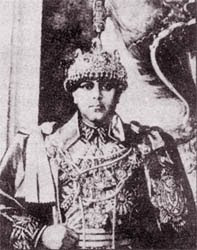
King Tribhuhvan Bir Bikram Shah , King of Nepal (June 30, 1906 – March 13, 1955) was King of Nepal from 11 December 1911 until his death, excepting a period in 1950-51. Born in Kathmandu, the capital city of Nepal, he ascended to the throne at the age of five, upon the death of his father, King Prithvi Bir Bikram Shah, and crowned on 20 February 1913 at the Nasal Chowk, Hanuman Dhoka Palace in Kathmandu, with his mother acting as regent. At the time, however, the position of monarch was mainly titular, with real power in the country residing in the powerful, conservative Rana family, which supplied the country with its hereditary prime minister.
Tensions between the royal family and the Ranas came to a head during World War I. The Ranas wanted to join the war in support of Britain, which controlled India to the south. The prime minister, HH Maharaja SriTeen Sri Chandra Shamsher Jang Bahadur Rana always had his way with the young king, who eventually ordered the troops to go to war.
By the mid-1930s, popular discontent with the Ranas led to the establishment of several movements, notably the Praja Parishad, which Tribhuvan himself gave explicit support, to overthrow the Ranas. Tribhuvan was an opportunist as he saw that the overthrow of the Ranas means that he will be the center of all power over the uneducated peasants of Nepal. In each instance, however, the Ranas responded harshly, banning the liberal movements and executing their leadership.
As in World War I, during World War II, Tribhuvan authorized the deployment of troops to aid British Imperial Forces.
After the war, the liberal democratic movement reorganized in Nepal.
Tribhuvan was too weak and feeble to lead any revolt against Ranas. An opportune he was, he saw another opportunity in making to the history books. In November 1950, Tribhuvan flees Nepal and makes his way to India. The Ranas responded by attempting to replace him with his grandson, Gyanendra. He deeply resented this grandson and wondered if he will ever return back to Nepal at all. He was a king without a kingdom and someone who is totally dependent on the goodwill of India. This realization drove him to depression.
The Nepalese people came to be his savior and fought against the Ranas and their army. With this war against the Rana, they could sense that their authority was being threatened. The last Rana prime minister Mohan Shamshere Jung Bahadur Rana eventually conceded to democratic reforms, but only after massive demonstrations and protests by Nepalese people for the establishment of democratic system in the country.
On February 18, 1951, King Tribhuvan returned from India as monarch. By November of that year, the prime minister resigned, ending Rana rule in the country.
He died in 1955 in Zurich, Switzerland under mysterious circumstances. He was succeeded by his eldest legitimate son Mahendra.
The international airport in Kathmandu, Tribhuvan International Airport, a city, Tribhuvannagar in Dang valley, and the country's largest university (Tribhuvan University) are named after him.
| Though it was the Nepali Congress, the Praja Parishad and other political forces that finally overthrew 104 years of Rana rule, the fact remains that King Tribhuvan 's calculated flight to New Delhi in 1950 was the one event that flung the Ranas into the dustbin of history. By the time he took that fateful flight, the King had become a rallying point for the anti Rana rebels. For all he did to overthrow the Ranas, King Tribhuvan, | |
King Tribhuvan's legacy, therefore, is one of initial optimism followed by missed opportunities, which changed the course of history in Nepal.
Honours
* Grand Cordon of the Order of the Supreme Sun of the Kingdom of Afghanistan-1950
* Grand Cross of the Order of Merit of the Republic of Italy-1954
* Grand Cross of the Legion of Honour of France-1954
0 comments:
Post a Comment